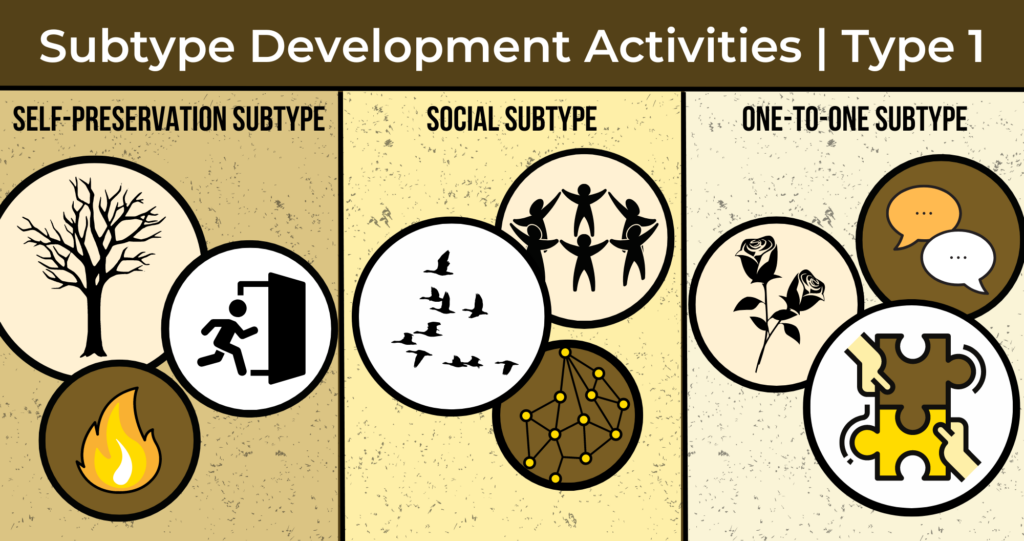There are three versions of each Enneagram type called subtypes: self-preserving subtype, social subtype and one-to-one subtype. Subtypes are formed when the emotional patterns or habits of our type, also called the type’s passion or vice, intersect and combine with one of the three basic human instincts, the instinct that is most activated within us: self-preservation instinct, social instinct or one-to-one instinct. We may have more than one activated instinct, so we could relate to two or even all three subtypes for our type.
Each instinct has specific focal areas. Individuals with that activated instinct, once it combines with the emotional pattern of our type, may move toward that instinctual area, away from that arena, or have ambivalence about that area. A way of understanding this is that the instincts by themselves are simply human and natural. However, when the activated instinct(s) combines with our type-based emotional pattern, the instinct then becomes distorted and, thus, less able to satisfy our natural needs in that instinctual area.
Here you can read about the passion or emotional habit of the type, a name for and a description of that subtype as it combines the emotional habit with that instinct, followed by one specific development idea that is particularly useful to people of that subtype. Please remember that we may have more than one active subtype, so the development activities for the additional subtype are also good for your development.
ONES
Emotional pattern of ANGER
The chronic dissatisfaction with self, others, life and work that are not as they should be.
Self-Preservation One subtypes
Self-Preservation One subtypes (“anxiety”) focus on getting everything structured, controlled, precise, and organized correctly, and experience anxiety, worry, and irritation when they think this may not happen.
Self-Preservation One subtype development
Notice the true or deeper sources of your anger, anxiety and thoughts about imperfection and control; relax more.
One way to relax more:
Breathe in a rhythmic and relaxed way, making sure to breathe throughout your body and not just into your upper chest and head. Practice this multiple times per day.
Social One subtypes
Social One subtypes (“non-adaptability” ) perceive themselves as role models of the right way of behaving and believe they set the standard for how others should be; they lead and influence by example, focusing their efforts on critiquing social institutions as a way to perfect them.
Social One subtype development
Notice your need to be right and perfect in the world; learn that your worth doesn’t depend on your being a near-perfect role model.
One way to work on not identifying your self-worth with your being a near-perfect role model:
Make a list of all the ways you put pressure on yourself to be so good and near-perfect. As you review this list, ask yourself this question: “Is what I do to be a role model worth the price of the pressure I put on myself?”
One-to-One One subtypes
One-to-One One subtypes (“zeal” ) have an intense need to perfect others, particularly those who matter to them and to perfect society in general, perceiving critiquing and reforming others as both their right and responsibility.
One-to-One One subtype development
Notice your need to improve and reform others; focus less on critiquing others and more on your own self-acceptance.
One way to focus less on critiquing others and more on your own self-acceptance:
Recognize that while you think you are being helpful when you tell someone something about themselves that could be better or improved, they are more likely to feel criticized by you. When you are about to say something that critiques someone else, pause and ask yourself: “Is my comment really going to be helpful? How might my comment harm this relationship?”
These activities are excerpts from the new additions to the soon-available 3rd edition of The Enneagram Development Guide, with over 60 development activities for each Enneagram type.
Ginger Lapid-Bogda PhD, author of nine Enneagram books, is a speaker, consultant, trainer, and coach. She provides certification programs and training tools for business professionals around the world who want to bring the Enneagram into organizations with high-impact business applications. TheEnneagramInBusiness.com | ginger@theenneagraminbusiness.com


Comments are closed.